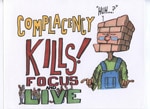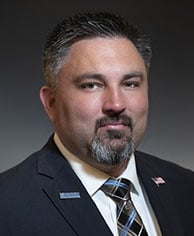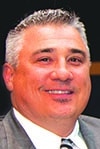As the SMART-TD restructures to better serve our membership, the National Safety Team (NST) now has a new director. SMART-TD Alternate National Legislative Director Jared Cassity (Local 1377 in Russell, Ky.) has taken over as director for SMART-TD Chief of Staff Jerry Gibson (Local 313 in Grand Rapids, Mich.).
“I have the utmost faith that Jared has the knowledge, experience and passion to lead this team,” Gibson said.
No stranger to the NST, Cassity joined the team in 2014 and served as an alternate director from 2016 to 2019. He has also served on the CSX Safety Model Executive Board.
Cassity started his railroad career with CSX in September 2005 and was promoted to engineer in 2008. He has held numerous positions within the union, including vice local chairperson, secretary and treasurer, legislative representative, local chairperson, assistant general chairperson, Kentucky state legislative director and alternate national legislative director.
“Safety is our priority, as it should be, but unfortunately we work in an industry that prioritizes profit before anything else. So, we must be vigilant to not just watch out for ourselves, but also to protect the backs of our brothers and sisters,” Cassity said. “As a union, we cannot let down our guard, and I pledge to maintain the necessary level of dedication and aggression that this job requires to get the job done.
“Our goal is simple: ‘to get you home the same way you came to work.’ I know that is an old saying, but it’s true. The safety of our brothers and sisters is worth fighting for, and the NST will do just that. Lastly, I would like to thank Brother Jerry for all the years he has dedicated to this team. What a difference for the better he has made.”
Brother Gibson hired out in 1996 as a conductor for CSX. In 1998, he was voted as terminal safety chairperson, serving in that position until 2000. That same year, he assisted with the formation of a new safety process and authored what became the UTU/CSX Safety Program in February 2000. He also led the training of safety coordinators on CSX and was responsible for employee safety, unsafe condition and procedure correction, accident investigation and prevention. He’s also served the union by presenting safety and legislative courses at regional meetings.
A nationally recognized safety expert, Gibson has met with authorities from all federal and state executive and legislative branches and has provided testimony and information in regard to railroad-related issues pertaining to safety and job retention. He has been a co-director of the NST since 2013. Although stepping down as co-director, Gibson will remain acutely engaged to consult on safety matters.
“Safety has always been a passion of mine and something I worked diligently to improve my entire railroad career. I have always believed that, as a fraternal organization, the safety of our fellow brothers and sisters must top all other priorities as one loss or injury is one too many. I know with the leadership and commitment to safety President Ferguson and General President Sellers have, and the skills and ability Jared possesses, this team will receive the support it needs to be successful, therefore, the time was right to hand over the baton. While I am stepping back, I am not walking away and will always be a resource and advocate … willing to assist at any time,” Gibson said.
Click here to visit the SMART-TD National Safety Team webpage.
Tag: Jerry Gibson

As an organization, we are known for digging deep into our pockets and reaching out to those less fortunate and in need when a tragedy strikes.
Michigan State Legislative Director Jerry L. Gibson and his family have been dealing with a tough issue of their own and Assistant State Legislative Director Don Silseth is asking SMART members to consider participating in the first Kelsey Gibson Benefit golf outing, dinner and auction.
Gibson’s daughter, Kelsey, was involved in a horrific car accident in January 2013. She was 21 at the time. Her life hung in the balance for weeks, but she endured.
Kelsey remains in a wheelchair and receives near daily therapy. She is totally dependent on others, yet Silseth says she is 100 percent cognizant.
There has been encouraging research in treatments that could be of great benefit to Kelsey, however, the estimated $160,000 to $220,000 cost is not covered by insurance.
A group of union brothers and sisters from within this organization and others have formed a committee to assist the Gibson family, Silseth said.
The committee is seeking golf participants as well as sponsors, and donations are appreciated. For complete details, visit www.FBOKelseyGibson.com. There are participant registration forms and sponsorship information.
The Kelsey Gibson Benefit will be held Saturday, June 20, at The Pines Gold Course in Wyoming, Mich.
“It is my hope that we can line the fairways with SMART union signs from across the United States and Canada. With strong fraternal support, we can begin to move this treatment from hopes and dreams to reality,” Silseth said.
“I am proud and fortunate to have Jerry Gibson as a fellow member of SMART Transportation Division Local 313 (Grand Rapids, Mich.). He is all union, all the time, and he never gives up on our issues. If you ever asked Jerry for help, I’m sure you received it. He won’t ask this of you, but I will. Please help if you can.”

Friends of the Gibson family have started a gun raffle to help raise money to assist Kelsey with her rehabilitation efforts. For $20 per ticket, participants have a chance to win a new Remington Model 870 Express. This 12-gauge pump gun has twin action bars to prevent binding and twisting.
The winner will be drawn when 200 tickets are sold or on Jan. 1, 2015. To purchase tickets, contact Bud Morse at (419) 619-9161, Scott Hockin at (616) 293-9918, Don Silseth at (616) 443-2613 or Jerry Gibson at (616) 308-6381. Checks can be made payable to “FBO Kelsey Gibson.”
Kelsey Gibson, 21, daughter of Michigan State Legislative Jerry Gibson and his wife Carmella, was seriously injured the morning of Jan. 29 in an automobile accident.
Kelsey, a student at Grand Valley State University and recently engaged to be married, was driving a Ford Escape when she was broadsided by a pickup truck in heavy fog. She remains hospitalized and in a coma.
A fund for the Gibson family has been established at FifthThird Bank. Send donations to: Stephanie Hickox, FifthThird Bank, 3980 Alpine Ave., Comstock Park, MI 49321. Make the check payable to “FBO Kelsey Gibson.” On the memo line put “#7168002785.”
Donations can be made at all FifthThird Banks nationwide. Visit any FifthThird Bank and ask to make a deposit into account #7168002785, FBO Kelsey Gibson.
“The doctors have told Jerry and Carmella that Kelsey is in for a long fight. That’s a lot of missed work and family expenses to be met,” said Don Silseth, UTU Local 313 treasurer and legislative representative. “If you can donate one day of pay, great. If you can donate a half day of pay, great. If you can donate one hour of pay, great. If you can offer continued prayers, great. It’s all needed and appreciated.”
To check on Kelsey’s progress, visit www.spectrum-health.org/carepages and clock on CarePages.com. Enter “Kelseygibson” in the search box. You will have to register with CarePages.com first.

Other rules and procedures are crystal clear, but the ballast-level application depends on an individual’s level of training and professionalism.
With conductor certification, this responsibility has been highlighted and enhanced, and retaining certification can depend on proper ballast-level application of operating rules.
This brings us to the proper application of one of the most important and consistent rules throughout the nation, which was put into place by the FRA to protect life, limb and property during circumstances that require the utmost attention to detail and all crew members’ undivided attention: restricted speed.
The foundation of restricted speed for all rail carriers is found at Code of Federal Regulations, Section 49, Part 236, Subpart G-Definitions § 236.812, dealing with speed restriction. It requires “A speed that will permit stopping within one-half the range of vision, but not exceeding 20 miles per hour.”
Many will read that statement and proceed at the limits of that definition — a speed of 20 miles per hour — completely overlooking the true intent of the regulation.
Restricted speed is not a posted speed that we strive to maintain. It is as crystal-clear a word that can be used in a procedure: Restricted based on circumstance –circumstance that only those in the locomotive cab can truly apply to ensure safe operation.
Is there a train ahead? Broken rail? Faulty signals? The circumstances surrounding the use of restricted speed may vary, but the importance of protecting life, limb and property never changes.
In short, restricted speed is a warning that something in front of you has the ability to get you fired, hurt or killed.
When restricted speed is required, the warning should bring one out of your seat – make the hair on the back of your neck stand – because that is how dangerous the situation is at that point.
When speed is restricted, every element of your job should have your undivided attention, looking for what lies ahead — moving at a speed that will allow stopping in an instant when the unknown becomes known.
An in-depth job briefing among crew members is a must, and at times should include contacting the dispatcher for as much pertinent information as possible.
When speed is restricted, engineers and conductors must insist that each other drop all other activities, remain vigilant and attentive at the task at hand.
Conductors must be in position to stop the movement immediately should any doubt arise that the train is not under control using the provided emergency brake handle on their side of the locomotive.
With conductor certification, you are now held accountable, and it is only logical that you place the train into emergency 10 times than to gamble with your life once.
In some cases, we struggle to find examples of others’ misfortune to bring to light our urgency to comply with rules and procedures. Unfortunately, during 2011 there were five serious accidents where, according to the National Transportation Safety Board, crewmembers “failed to operate their trains at the required restricted speed.” Two of these accidents resulted in crew fatalities:
* Red Oak, Iowa, April 17, 2011, on BNSF
* Low Moor, Va., May 21, 2011, on CSX
* Mineral Springs, N.C., May 24, 2011, on CSX
* DeWitt, N.Y., July 6, 2011, on CSX
* DeKalb, Ind., Aug. 19, 2011, on Norfolk Southern
Be wise and learn from the mistakes of others who failed to follow rules, procedures and signal systems that were designed over decades to prevent such collisions.
The UTU Safety Task Force urges you to operate at a speed that will allow you to go home to your family in once piece — never allowing others to set your level of personal safety.
Fraternally,
UTU Safety Task Force
Greg Hynes
Steve Evans
Jerry Gibson
To read other Rail Safety Alerts from the UTU Rail Safety Task Force, click on the following link:
https://www.smart-union.org/safety/smart-rail-safety-task-force/
UTU Michigan State Legislative Director Jerry Gibson knows the value of the UTU PAC in electing labor friendly lawmakers. He knows how to share those facts, also.
UTU Local 1075 Secretary-Treasurer John Purcell says he and other members of his Trenton, Mich., local had “no clue of what the UTU PAC was. No one had ever explained how it worked” until Gibson showed up at a union local meeting.
Purcell credits Gibson with educating the local’s members “on how PAC funds are used and the benefits the PAC provides. I started contributing myself immediately and began to encourage others to do the same,” Purcell said in a recent e-mail he sent Gibson.
“The value of the UTU PAC was further driven home after my attendance at the regional meetings where I learned what was being done in Washington D.C., and the impact of our PAC funds there,” Purcell said.
More recently, Purcell said the UTU’s get-out-the vote drive for the Nov. 2 elections was a success. Post cards sent members through a project of the National Legislative Office “reached the members’ homes and several contacted me and asked questions,” Purcell said.
“I provided information which included that the UTU PAC is not a partisan program and that it supports candidates that support us regardless of party affiliation,” Purcell said. “I used the information provided, which listed successful legislation that has improved safety and benefits.
“All of this resulted in 12 members either increasing their UTU PAC donation or becoming new donors all together,” Purcell said.
Purcell said he now writes a check to the UTU PAC in the amount of $265 per month, and 44 percent of Local 1075’s members now donate. He said his goal is to gain PAC contributions from 75 percent of Local 1075’s members.

